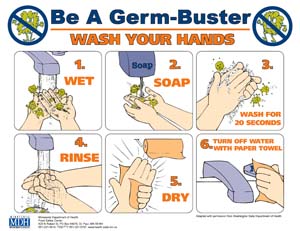By Barbara Ficarra, RN, BSN, MPA
 It’s always frightening to learn of outbreaks that the CDC labels as a “public health emergency”.
It’s always frightening to learn of outbreaks that the CDC labels as a “public health emergency”.
While the swine flu may be new to us in name, it’s not new to us in what it is at its core, how we have to prepare ourselves for it, should it arrive in our area, and what we can do to protect ourselves.
The reason we now see it in humans is due to mutations that have occurred in the original animal viral.
According to the CDC, the swine flu strain infecting humans is not pure swine flu but actually a genetic mix of swine flu, influenza virus or human flu, and avian (bird) flu.
Don’t let the phrase “public health emergency” scare you too much. Not only is this virus not as strong as the influenza virus we prepare ourselves for each flu season, you already know how to prepare for the swine flu should it come to your area!
Precautions
The same precautions you take for the human flu are all you need to take for the swine flu to stay safe. Really, it is that simple.
As reminder:
- If sick, stay home. (The CDC recommends adults stay home for 7 days after symptoms begin and kids stay home for 10 days after symptoms begin.)
- Good hand washing.
- Throw away used tissue and cough in the elbow of your arm.
- Call your doctor with any concerns about any member in your home with flu symptoms.
Prevention
Of all these flu illness prevention strategies, hand washing is one of the easiest and most important to stop any flu in its tracks.
Have you ever gone into a public restroom and notice that some people don’t wash their hands? Have you ever noticed someone sneezing or coughing into their hands and then they go to pick up a telephone, use a computer, press an elevator button or touch a doorknob?
Without good hand washing, each of these people is essentially a walking aerosol can of germs and if you get their germs, good chance you’ll get sick.
Without a doubt, hand washing is the single most effective way to keep germs at bay and prevents illness and infection. But, you have to do it the right way for it to be effective.
Here’s a quick guide on hand washing that will zap any germ in its tracks:
- Turn the faucet on with a paper towel. (While the CDC recommends only turning off the faucet with a paper towel, it’s a good idea to use one to turn it on since the sink is contaminated).
- Wet your hands with warm running water and apply soap.
- Rub hands together vigorously to make a soapy lather.
- Rub all surfaces including your wrists, between your fingers, back of your hands and under your fingernails and cuticles, and around any rings.
- Rub your hands for 15-20 seconds.
- No timer is needed; just imagine singing “Happy Birthday” x 2.
- Rinse your hands well.
- Dry your hands using a paper towel or air dryer.
- Use your paper towel to turn off the faucet if possible.
- Always use soap and water if your hands are visibly dirty.
Alcohol-based hand sanitizers are an excellent alternative if soap and water are not available.
Remember, good health hygiene is critical and as parents, it’s really important to teach our kids good health hygiene from the very start so healthy habits can continue as they get older.
Our human flu season may have winded down but if you regroup on all those flu tips we once discussed and become hand washing fanatics for a bit, you’ll tell that swine flu who’s boss and give it a race hard for it to win.
For more Information:
Co-Authored with Gwenn Schurgin O’Keefe, MD, FAAP Pediatricsnow.com

Great tips! Remember to check your vitamin D levels. Ask your doctor for the 25 hydroxy D test, its the best! If your level is optimal (about 70), your chances of catching a respiratory infection, such as the swine flu, drops significantly.